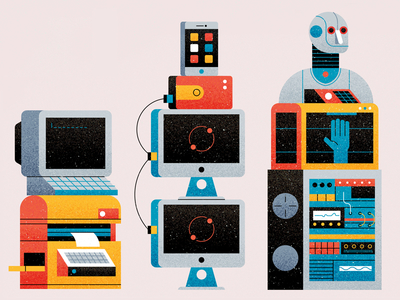
The Impact Of Data and Visuals In A Storytelling

What is Visualization?
Visualization is the process of representing or showcasing data in a pictorial format and interacting with these representations in order to gain insight into the data or information.
The act of visualization is useful in many ways.
We live in a data-packed world where tech is advancing at an incredible pace. The quantity of data is growing at a persistent speed creating what is known to be Big Data.
Big Data involves datasets that grow to such an enormous size that it becomes difficult to work with them using the traditional data management applications. Hence, the importance of Visualisation.
The beauty of excellent content is that it will have the ability to paint a clear picture in the reader’s mind, just as truly effective visuals should tell a story with the data we have.
Here are the six different types of Visualisation used in this day and age as per Curtin University.
Information Visualization
Information Visualization is concerned with the design, development, and application of computer-generated interactive graphical representations of information. This often implies that information visualization primarily deals with abstract, non-spatial data.
Transforming such non-spatial data to intuitive and meaningful graphical representations is therefore of fundamental importance to the field. The transformation is also a creative process in which designers assign new meanings into graphical patterns.
Like art, information visualization aims to communicate complex ideas to its audience and inspire its users for new connections. Like science, information visualization must present information and associated patterns rigorously, accurately, and faithfully” (Chen, 2015).
Data Visualization
Data visualization is the use of tools to represent data in the form of charts, maps, tag clouds, animations or any graphical means that make content easier to understand. Graphic representations of data are popular because they open up the way we think about data, reveal hidden patterns, and highlight connections among elements.
The current web applications allow anyone with access to data to enter information and easily create a virtualization of it, students, informal learners, and the purely curious can now easily create visualizations that might reveal trends that were not obvious from the numbers alone.
For scholars, particularly those whose conclusions depend on the interpretation of complex statistics, data visualization offers the promise of easier communication and a wider audience for their findings.

Be Visual.
Scientific Visualization
This type of visualization is used by Scientists to explore medical, biological, architectural and meteorological subjects. The information is often visualized in 3D and relies on the most advanced technology (computers) to model and analyze very large data sets.
Scientific visualization is focussed on presenting data to users by means of images, in the hope that the data aids understanding.
A combination of Information, Data and Scientific visualization is very crucial for a solid format of storytelling for your brand in order to make it digestive for your audience.
Visual Power
Visuals have the power to tell a brand’s story or to explain new features and products without excessive information or detailed picture of a particular product or service. It’s easy to grasp and learn from.
As humans, who are visual storytellers by nature, therefore applying the basic principle for the audience or potential customers will create and a better bond between the brand and the audience which otherwise would go under the radar.
The idea behind data visualization is that the same information which is represented graphically could be written about endlessly, or it could be illustrated in any other format for better consumption. With precise data and effective format, you could hit a home run with any category of the audience irrelevant of the niche or category of data which you plan to visualize.
Data visualization plays a massive role in transforming a boring spreadsheet data into a visual treat for the audience to consume. That’s why visuals are so effective and explosive for this day and age.
If a picture like everyone says, is worth a thousand words, think of how easily communicated a single piece of data can be in pictorial format.
Still, its crucial for data to meet the design. Complexities of information can often be difficult to communicate through written language.
When finally picturing the data, it is very important to spot the valuable insights to sort of the out data which needs to be visualized to see which metrics matter the most from the set of data. Finding the sweet spot to visualize the right data is the key.
Visual data can depict growth, unique site visits specific to certain marketing campaigns, the success of your marketing efforts, and its effect on different populations and target audiences.
The job of data visualization and infographics alike is to simplify the message being delivered. Stories can too easily become lost on the audience when graphs require them to do too much work of their own which would make the whole process useless.
When written content and visual format aligns in a perfect ratio, it would make your brain actively work and process to mentally understand the information being presented to them. Studies have found that images can improve learning by up to 400%! Hence, the ability to grasp information gets exponentially better and faster processing.
Don’t agree? The rapid growth of Instagram in a short span of time implies the importance of visual content over the text-based content platform like Twitter. And they also have the probability to go viral compared to other formats.

People interacting with charts and analyzing statistics.
So, content must have a defining factor that stays in the viewer’s minds. It must be deemed worthy of being shared by the audience it is shown to. Often times edits and changes are required to be made to the initial piece of content before it effectively goes viral. Viral content is universally adored. And more often than not, it comes in the form of easily digestible imagery.
At the point when an account is combined with convincing imagery, content turns out to be all the more effortlessly known by the audience. Since outwardly prepared data is less demanding to digest, components, for example, shading, size, and introduction are only a portion of the numerous qualities that can have the universal effect for your audience by communicating with data.
The Value of Data Visualization from Column Five.
Designs have no bounds. There is nothing that can’t be vanquished and conveyed by intense outline or meaning. We correlate color with certain meaning, view different shapes and sizes to represent quantity, and general direction or orientation of something can depict trends.
While we are surrounded by data like numbers, factual descriptions, stats, nothing is so stale that it cannot be revived by amazing imagery.
Visual data has the unique ability to convey statistics and numbers in a way that simple written language just cannot. And when the two are paired together in an effective infographic, they are a force to be reckoned with.
We at Wishtree will soon be putting forward something special for you guys in the coming days with information packed in the format of Infographics. So stay tuned and do visit us again to see what we have in store for you guys.
To Note:
- Shareability is what makes visuals a key player in the big game of content disstribution.
- People more easily respond to graphic content, and viral videos and images perfect examples for that.
- Regardless of the medium or platform, only quality and on-point content is worth sharing according to your audience.
- With over 75 million active users on Instagram daily, you could potentially attract over 150 million eyeballs to your content if they are graphic or visual in any means.
- Visual data has the unique ability to convey statistics and numbers in a way that simple written language cannot.





ww88
September 17, 2021 at 1:49 pm… [Trackback]
[…] Info on that Topic: wishtreeinfosolutions.com/data-and-visuals-in-a-storytelling/ […]
darkfox market
September 27, 2021 at 8:34 pm… [Trackback]
[…] Here you can find 57489 additional Information to that Topic: wishtreeinfosolutions.com/data-and-visuals-in-a-storytelling/ […]
Illuminati Romania
October 2, 2021 at 5:14 pm… [Trackback]
[…] Find More to that Topic: wishtreeinfosolutions.com/data-and-visuals-in-a-storytelling/ […]
Fortune Games® Real Money Casino Slot Games Slots
October 4, 2021 at 6:22 pm… [Trackback]
[…] Read More Information here on that Topic: wishtreeinfosolutions.com/data-and-visuals-in-a-storytelling/ […]
relx
October 9, 2021 at 5:49 am… [Trackback]
[…] Find More to that Topic: wishtreeinfosolutions.com/data-and-visuals-in-a-storytelling/ […]
https://claimbo.com/company/zilis/
October 13, 2021 at 9:29 pm… [Trackback]
[…] Read More on that Topic: wishtreeinfosolutions.com/data-and-visuals-in-a-storytelling/ […]
สล็อตเว็บตรง
November 12, 2021 at 9:22 pm… [Trackback]
[…] Find More to that Topic: wishtreeinfosolutions.com/data-and-visuals-in-a-storytelling/ […]
nova88
November 19, 2021 at 5:48 am… [Trackback]
[…] Find More on that Topic: wishtreeinfosolutions.com/data-and-visuals-in-a-storytelling/ […]
Construction Surveillance
November 27, 2021 at 9:03 pm… [Trackback]
[…] There you can find 45419 additional Info on that Topic: wishtreeinfosolutions.com/data-and-visuals-in-a-storytelling/ […]
sekabet giris
December 11, 2021 at 1:38 am… [Trackback]
[…] Find More here to that Topic: wishtreeinfosolutions.com/data-and-visuals-in-a-storytelling/ […]
บาคาร่า1688
December 18, 2021 at 5:47 am… [Trackback]
[…] There you can find 40185 additional Info on that Topic: wishtreeinfosolutions.com/data-and-visuals-in-a-storytelling/ […]
kardinal stick
January 2, 2022 at 5:38 am… [Trackback]
[…] Find More on that Topic: wishtreeinfosolutions.com/data-and-visuals-in-a-storytelling/ […]
슬롯게임
January 7, 2022 at 3:11 pm… [Trackback]
[…] Information on that Topic: wishtreeinfosolutions.com/data-and-visuals-in-a-storytelling/ […]
2license
January 13, 2022 at 5:13 am1compliance
321 gay teen chat
January 14, 2022 at 6:16 pmfcn chat gay https://bjsgaychatroom.info/
college gay dating dite
January 14, 2022 at 9:05 pmfree gay twink dating https://gaypridee.com/
best gay chat site 2017
January 15, 2022 at 12:34 amlocal gay chat rooms https://gaytgpost.com/
free gay chat fcn
January 15, 2022 at 1:15 amdos chicos se conocieron en un chat gay https://gay-buddies.com/
gay dating
January 16, 2022 at 2:05 amgay dating naked https://speedgaydate.com/
free slots triple diamond
January 28, 2022 at 10:47 pmlas vegas slots free https://2-free-slots.com/
slots blaze casino
January 29, 2022 at 3:02 ambig fish slots https://freeonlneslotmachine.com/
casino slots
January 29, 2022 at 4:41 amvegas slots online https://candylandslotmachine.com/
dragon slots
January 29, 2022 at 10:53 amcard game slots https://pennyslotmachines.org/
hollywood fun slots
January 29, 2022 at 1:04 pmheart of vegas slots https://slotmachinesworld.com/
dnd level 6 spell slots
February 3, 2022 at 9:51 pmfree slots download for pc https://slotmachinesforum.net/
hit it rich slots
February 4, 2022 at 3:41 am777 slots free https://slot-machine-sale.com/
free kronos slots for fun
February 4, 2022 at 6:48 amfilthy rich slots free https://beat-slot-machines.com/
best us online slots
February 4, 2022 at 8:02 amscatter slots cheats https://download-slot-machines.com/
icy wilds slots
February 4, 2022 at 1:22 pmfree quarter diamond slots https://411slotmachine.com/
scatter slots by murka
February 4, 2022 at 4:31 pmplay slots for real money https://www-slotmachines.com/
100 percent free slots
February 4, 2022 at 9:32 pmharts of gold free slots https://slotmachinegameinfo.com/
บริษัท กรีนพลัส (ไทยแลนด์) จำกัด
February 10, 2022 at 10:05 pm… [Trackback]
[…] Read More on that Topic: wishtreeinfosolutions.com/data-and-visuals-in-a-storytelling/ […]
dissertation help in los angeles
February 11, 2022 at 1:15 amumi dissertation services https://buydissertationhelp.com/
law dissertation writing service uk
February 11, 2022 at 7:28 pmtop rated dissertation writing services https://dissertationwriting-service.com/
best dissertation writing service uk
February 12, 2022 at 2:13 amdissertation chapters https://help-with-dissertations.com/
masters dissertation writing help
February 12, 2022 at 6:01 amdissertation help services https://mydissertationwritinghelp.com/
custom dissertation writing help
February 12, 2022 at 8:38 amdissertation writing https://dissertations-writing.org/
it dissertation help
February 12, 2022 at 1:10 pmhow long is a dissertation https://helpon-doctoral-dissertations.net/